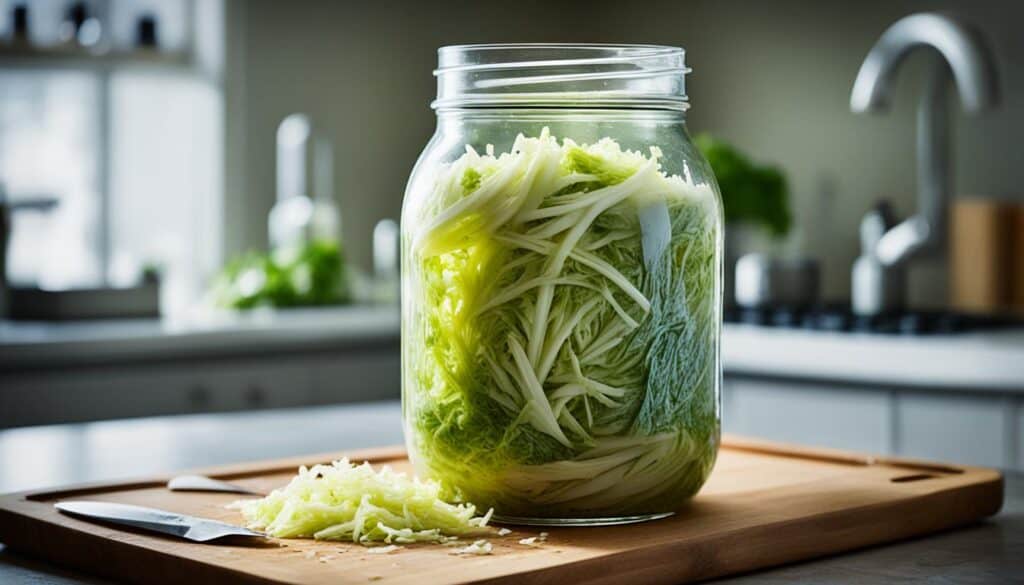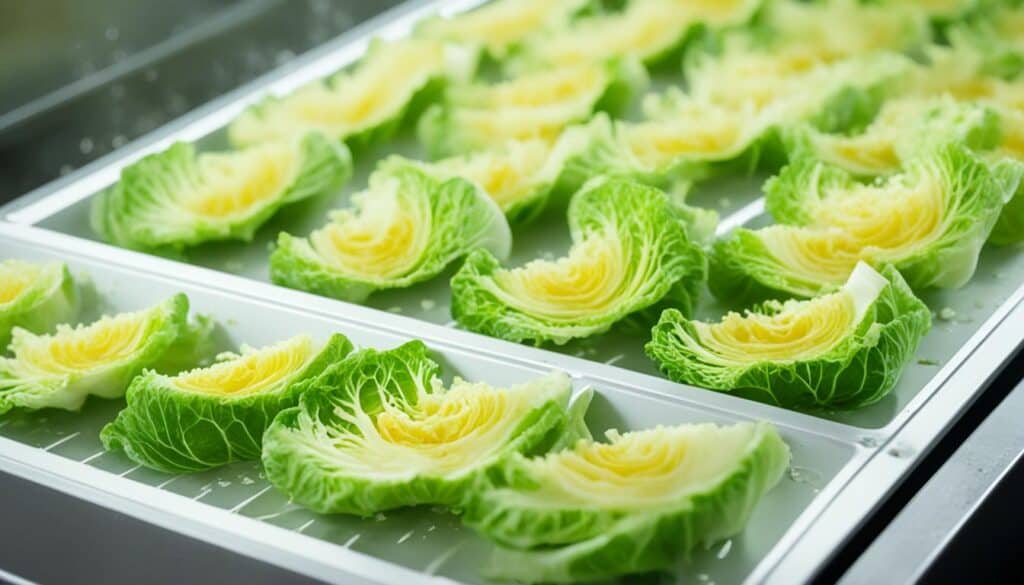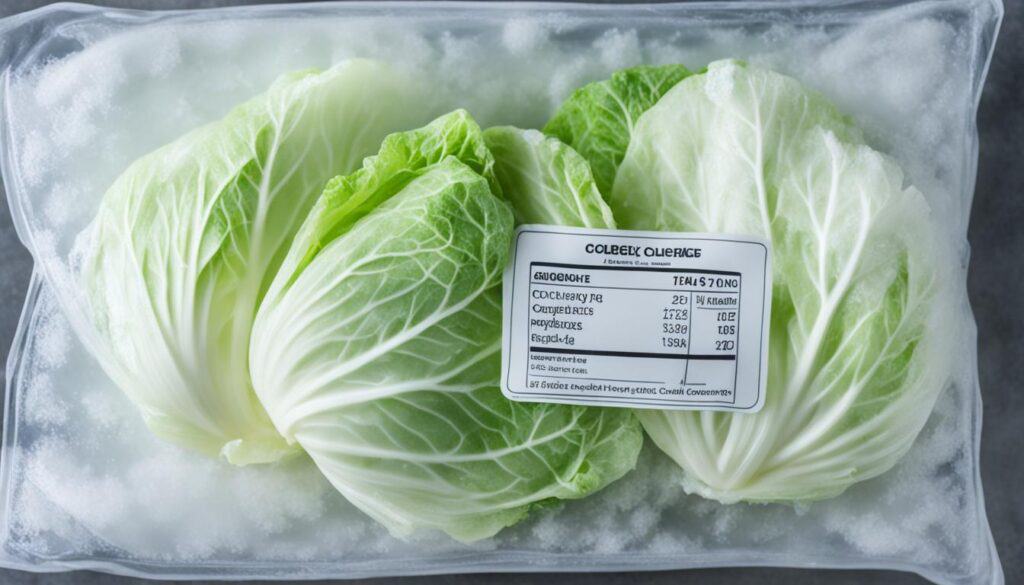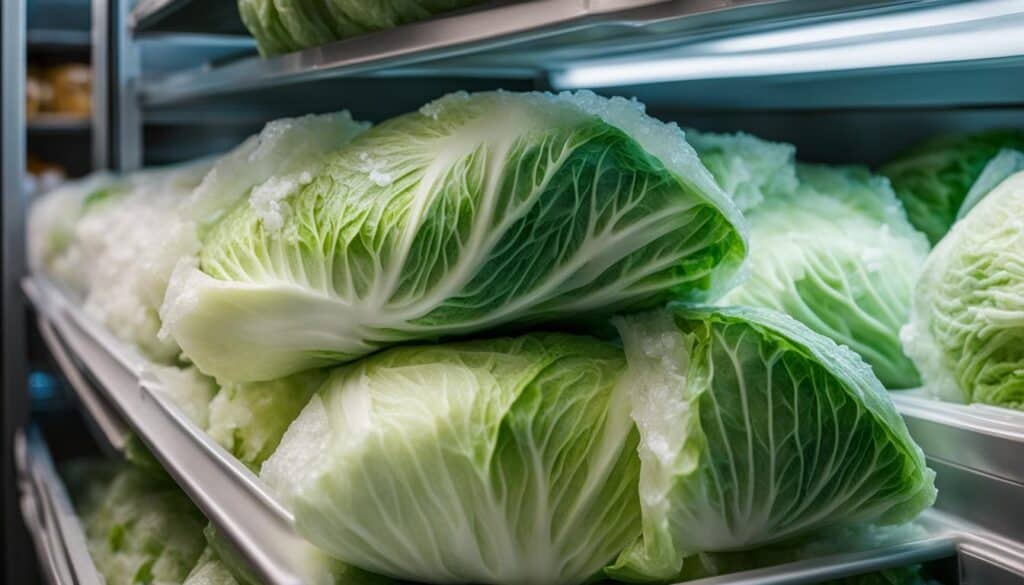Did you know that cabbage can be stored for up to 12 months by freezing it? Yes, you read that right! Freezing cabbage is a simple and effective way to preserve this versatile vegetable for long-term use. Whether you grow your own cabbage or buy it in bulk, freezing is the best way to ensure that you always have fresh cabbage on hand, even months after the harvest. In this article, I will share with you the step-by-step process of how to freeze cabbage, along with some valuable tips for successful storage. So, let’s dive in and discover the secrets to preserving your cabbage bounty!
Key Takeaways:
- Freezing cabbage is a practical method for long-term storage.
- Select firm and heavy cabbage heads with crisp leaves for freezing.
- Harvest cabbage just before the first frost for optimal flavor and nutrition.
- Store cabbage in containers or on shelves with proper air circulation.
- Regularly check for any decaying or damaged heads to prevent spoilage.
Choosing the Right Cabbage for Freezing
When it comes to selecting cabbage for freezing, it’s important to consider the type of cabbage that best suits your needs. Different varieties of cabbage offer unique flavors and characteristics that can enhance your culinary creations. Two popular types of cabbage for freezing are Savoy cabbage and Napa cabbage.
Let’s take a closer look at these varieties:
| Type of Cabbage | Description | Best Use |
|---|---|---|
| Savoy Cabbage | Savoy cabbage features crinkly leaves and has a mild, tender taste. Its leaves are more pliable compared to other cabbage varieties, making it perfect for wrapping and stuffing dishes. | Ideal for dishes that require a delicate and mild cabbage flavor, such as cabbage rolls and stuffed cabbage. |
| Napa Cabbage | Napa cabbage has a milder taste and a crunchy texture. It is often used in Asian cuisine and is great for fermenting. | Perfect for making homemade kimchi or adding a refreshing crunch to salads and stir-fries. |
Regardless of the type of cabbage you choose, there are a few key factors to consider when selecting cabbage heads for freezing. Look for cabbage heads that feel firm and dense in your hands. The outer leaves should be bright and tightly packed, indicating freshness. Avoid cabbage with soft spots or damage from bugs, as these may affect the quality of the cabbage during storage.
Additionally, consider the size and shape of the cabbage head. Depending on your storage space and consumption needs, you may prefer larger or smaller cabbage heads. Aim for uniformity in size and shape, as this ensures even maturation and better storage results.
Remember, selecting the right cabbage is the first step towards successful cabbage storage. So, choose wisely to enjoy the best flavors and textures when using your frozen cabbage in various recipes!
- “Types of Cabbage” – The Spruce Eats
- “Cabbage: Types, Selection, and Storage” – University of Illinois Extension
Harvesting and Preparing Cabbage for Freezing
When it comes to freezing cabbage, proper harvesting and preparation are essential to ensure the best results. Here are the steps to follow:
- Harvest the cabbage when it is fully grown, firm, and has a slight give when gently squeezed. Use a sharp knife to cut the cabbage head from the soil, making a clean cut to prevent the spread of disease.
- Remove any wilted or damaged outer leaves, but leave a few attached leaves to protect the inner layers during storage.
- To preserve the crispness of the cabbage, it is best to harvest it in the morning when temperatures are cooler.
- Clean the cabbage thoroughly by rinsing it under cold water. Remove any dirt or debris.
- Shred the cabbage into small pieces. This can be done using a knife or a mandoline slicer.
- Blanch the shredded cabbage in boiling water for a few minutes. Blanching helps preserve the cabbage’s color, texture, and nutrients.
- After blanching, immediately transfer the cabbage to an ice bath to stop the cooking process. This will help retain the crispness and flavor.
- Drain the blanched cabbage well to remove excess moisture.
- Pack the drained cabbage into freezer bags, removing as much air as possible to prevent freezer burn. Properly label the bags with the date for easy tracking.
Following these steps will ensure that your cabbage is properly prepared for freezing, preserving its quality and taste for future use.
| Step | Description |
|---|---|
| 1 | Harvest fully grown, firm cabbage heads with a clean cut. |
| 2 | Remove wilted or damaged outer leaves, leaving a few to protect inner layers. |
| 3 | Harvest in the morning for cooler temperatures and better crispness. |
| 4 | Clean cabbage thoroughly by rinsing under cold water. |
| 5 | Shred cabbage into small pieces using a knife or mandoline slicer. |
| 6 | Blanch shredded cabbage in boiling water for a few minutes. |
| 7 | Transfer blanched cabbage to an ice bath to stop the cooking process. |
| 8 | Drain blanched cabbage well to remove excess moisture. |
| 9 | Pack drained cabbage into freezer bags, removing air and labeling with date. |
Please note: For visual reference, here’s an image of a cabbage ready for harvesting:
Now that your cabbage is harvested and prepared, it’s ready to be frozen for long-term storage. The next section will cover the best practices for storing cabbage to maintain its quality over time.
Storing Cabbage for Freezing
When it comes to preserving cabbage for freezing, proper storage conditions are crucial to maintain its freshness and quality. The optimal environment for cabbage storage is a cool and moist one, such as a root cellar. This storage area should be kept at a constant temperature of 32 degrees Fahrenheit and a relative humidity of 95%. These conditions help to slow down the aging process and prevent the growth of mold or rot.
Proper air circulation is essential when storing cabbage. It helps to prevent moisture buildup, which can lead to decay. To ensure good air circulation, consider placing the cabbage heads on shelves or in containers that allow for adequate airflow.
To further protect the cabbage during storage, wrapping each head in a layer of newspaper can be beneficial. The newspaper acts as insulation and absorbs any excess moisture that may accumulate. This additional layer of protection helps to maintain the crispness and freshness of the cabbage.
Regularly checking stored cabbages is important to identify any signs of spoilage or damage. Remove any decaying or damaged heads to prevent the spread of spoilage to other cabbages. It’s also advisable to keep different types of cabbage separated during storage. This helps maintain consistent quality and prevents the transfer of flavors or odors between different varieties.
Darkness and ventilation are key factors to consider when storing cabbage. Keep the storage area dark to prevent the growth of chlorophyll, which can affect the color and taste of the cabbage. Additionally, ensure there is proper ventilation to prevent the buildup of ethylene gas, which can accelerate the aging process of the cabbage.
| Storage Conditions | 32°F Temperature | 95% Relative Humidity |
|---|---|---|
| Cool and Moist Environment | Prevents decay and maintains freshness | |
| Proper Air Circulation | Prevents moisture buildup | |
| Newspaper Wrapping | Absorbs excess moisture and provides insulation | |
| Regularly Check Cabbages | Remove decaying or damaged heads | |
| Separate Different Types | Maintains consistent quality | |
| Darkness and Ventilation | Prevent chlorophyll growth and ethylene gas buildup | |
By following these optimal storage conditions, you can ensure that your frozen cabbage remains in excellent condition for an extended period, allowing you to enjoy its crispness and flavor even after months of storage.
Refrigerating Cabbage for Short-Term Storage
If you plan to use cabbage within a few weeks, refrigeration is a great short-term storage method. After harvesting, discard any limp or wilted outer leaves and keep only the clean and sturdy ones.
Place the whole cabbage in the vegetable crisper drawer of the refrigerator. To prevent moisture loss, you can wrap the cabbage in a damp paper towel and place it in a perforated plastic bag.
Check the cabbage regularly for any signs of softening or discoloration. Use it as soon as possible for the best flavor and texture.
Fermenting Cabbage for Long-Term Storage and Live Culture
Fermenting cabbage is a traditional method of preserving it for long-term storage. It not only improves taste but also provides probiotics that are beneficial for the digestive system.
To ferment cabbage, start by shredding it and following a sauerkraut recipe for step-by-step guidance on the fermentation process. Fermentation typically takes several weeks and results in a sour and delicious side dish.
Fermented cabbage, also known as sauerkraut, can be a versatile ingredient in various recipes, including stir-fries, soups, and casseroles.
Experimenting with different fermentation techniques can provide a unique and flavorful addition to your meals.
Benefits of Fermented Cabbage
“Fermented cabbage is not only delicious but also offers numerous health benefits. The fermentation process enhances the cabbage’s natural flavors while also increasing its nutritional value. Fermented cabbage, like sauerkraut, is a source of live bacteria known as probiotics, which are beneficial for gut health. Additionally, fermenting cabbage can help improve digestion and nutrient absorption.”
How to Make Fermented Cabbage (Sauerkraut)
To make sauerkraut, you will need:
- 1 cabbage head
- 1 tablespoon of sea salt
Follow these steps:
- Remove the outer leaves of the cabbage head and set them aside.
- Shred the cabbage into thin strips using a sharp knife or a mandoline slicer.
- Place the shredded cabbage in a large bowl.
- Add the sea salt to the cabbage.
- Massage the salt into the cabbage for about 5 minutes, until it starts to release its juices.
- Transfer the cabbage and its juices into a clean glass jar.
- Press down the cabbage to submerge it in its own juices.
- Place a clean cabbage leaf on top of the shredded cabbage to keep it submerged.
- Cover the jar with a clean cloth or a fermentation lid.
- Let the cabbage ferment at room temperature for about 2 to 4 weeks, depending on your desired level of sourness.
- Check the sauerkraut regularly and remove any mold or scum that may form on the surface.
- Once fermented to your liking, transfer the sauerkraut to the refrigerator for long-term storage.
Enjoying Fermented Cabbage
Fermented cabbage, or sauerkraut, can be enjoyed in a variety of ways:
- Add sauerkraut to a sandwich or a hot dog for an extra tangy kick.
- Incorporate sauerkraut into stir-fries for added flavor and texture.
- Use sauerkraut as a topping for sausages, burgers, or tacos.
- Add sauerkraut to soups, stews, or casseroles for a delicious twist.
- Include sauerkraut in salads or Buddha bowls for a probiotic boost.
Get creative with your fermented cabbage and discover new ways to enjoy its unique flavor and health benefits.
Dehydrating Cabbage for Space-Saving Storage
Dehydrating cabbage is a simple and efficient method to preserve this versatile vegetable for long-term storage. Not only does it save space in your pantry, but it also allows you to enjoy the nutritional benefits of cabbage throughout the year. By dehydrating cabbage, you can create a convenient supply of this leafy green that can be easily incorporated into your favorite recipes.
To begin the dehydrating process, start by cutting the cabbage into thin slices. The slices should be uniform in thickness to ensure even drying. Arrange the cabbage slices on the dehydrator trays, making sure to leave space between each slice for proper air circulation.
Set the dehydrator to a temperature between 125-135°F and let it run until the cabbage is completely dry. The drying time can vary depending on the thickness of the slices and the moisture content of the cabbage, so it’s essential to periodically check the progress.
| Temperature | Drying Time |
|---|---|
| 125°F | 8-10 hours |
| 135°F | 6-8 hours |
Once the cabbage is dry, remove it from the dehydrator and let it cool to room temperature. It’s crucial to allow the cabbage to cool completely to prevent condensation and spoilage during storage. Once cooled, transfer the dried cabbage to glass jars or vacuum-sealed bags for long-term storage.
When using dehydrated cabbage in recipes, such as soups, stews, or stir-fries, it’s important to rehydrate it first. Simply add the desired amount of dried cabbage to your dish and cook it with plenty of liquid. The cabbage will absorb the moisture and regain its original texture and flavor.
Dehydrated cabbage offers a convenient and space-saving solution for preserving this nutritious vegetable. With proper storage and rehydration, you can enjoy the taste and benefits of cabbage in your meals all year round.
Freezing Cabbage for Extended Storage
Freezing cabbage is a simple and effective way to preserve its freshness and extend its storage life. By following a few easy steps, you can enjoy the flavor and nutritional benefits of cabbage all year round.
To freeze cabbage, start by cleaning and shredding the cabbage into desired sizes. Remove any wilted or damaged leaves. Blanching the cabbage before freezing helps preserve its color, texture, and flavor. To blanch, bring a pot of water to a boil and carefully add the shredded cabbage. Let it cook for a few minutes until it becomes tender but still crisp.
After blanching, it’s important to cool the cabbage quickly to halt the cooking process. Plunge the blanched cabbage into an ice bath for a few minutes to cool it down. Once cooled, drain the cabbage thoroughly to remove excess moisture. Excess moisture can lead to a loss of quality and texture when frozen.
Now it’s time to pack the cabbage for freezing. Use freezer-safe bags or airtight containers to store the cabbage. It’s essential to remove as much air as possible from the packaging to prevent freezer burn. Label each bag or container with the date of freezing for easy tracking.
When using frozen cabbage, there’s no need to thaw it before adding it to your recipes. Simply take out the desired amount of frozen cabbage and add it directly to your stir-fries, soups, or casseroles. Frozen cabbage retains its flavor and texture when cooked, making it a convenient option for quick and easy meals.
Here’s a summary of the steps to freeze cabbage:
- Clean and shred the cabbage into desired sizes.
- Blanch the shredded cabbage in boiling water for a few minutes.
- Cool the blanched cabbage in an ice bath and drain thoroughly.
- Pack the drained cabbage into freezer-safe bags or containers, removing excess air.
- Label each bag or container with the date of freezing for easy tracking.
- Use the frozen cabbage directly in cooked dishes without thawing.
By freezing cabbage, you can enjoy the taste of summer in your favorite cabbage recipes throughout the year. Whether it’s adding frozen cabbage to stir-fries, soups, or casseroles, this versatile vegetable will bring a burst of freshness to your winter meals.
| Benefits of Freezing Cabbage | |
|---|---|
| Preserves Freshness: | Freezing cabbage helps retain its fresh flavor, texture, and nutritional value. |
| Extended Storage: | Frozen cabbage can be stored for several months, allowing you to enjoy it even when it’s out of season. |
| Convenient Usage: | No need to thaw frozen cabbage before adding it to recipes. |
| Versatile Ingredient: | Frozen cabbage can be used in various dishes, including stir-fries, soups, and casseroles. |
With freezing cabbage, you can easily stock up on this nutritious vegetable and enjoy its delicious taste all year long. Whether you’re craving a hearty stew or a crunchy slaw, frozen cabbage is a convenient and versatile ingredient to have in your freezer.
Alternative Methods of Cabbage Storage
In addition to traditional methods of cabbage storage, there are alternative methods that you can explore. These alternative techniques offer unique ways to preserve cabbage and enhance its flavor. Let’s take a closer look at two alternative cabbage storage methods: fermenting whole cabbage heads and harvesting cabbage with roots intact.
Fermenting Whole Cabbage Heads
Fermenting whole cabbage heads is a traditional method that results in delicious and flavorful cabbage rolls and other dishes. The process involves allowing the cabbage heads to ferment over time, which not only enhances their taste but also promotes the growth of beneficial probiotics. The tangy flavor and vibrant texture of fermented cabbage make it a popular ingredient in various cuisines around the world.
“Fermenting whole cabbage heads is a time-honored method that creates a unique and bold flavor profile. The natural fermentation process adds depth and complexity to the cabbage, making it a versatile ingredient for a variety of dishes.” – Fermentation expert
To ferment a whole cabbage head, begin by removing any wilted outer leaves and keeping only the clean and sturdy ones. Make a small incision at the base of the cabbage head to allow for the release of gases during the fermentation process. Place the cabbage head in a fermentation vessel or airtight container, ensuring that it remains submerged in its own brine. Allow the cabbage to ferment at room temperature for several weeks, checking periodically for desired taste and texture.
Harvesting Cabbage with Roots Intact
Harvesting cabbage with the roots intact allows for extended storage in root cellars or other suitable environments. By leaving the roots attached, you can hang the cabbage heads upside down or place them on shelves, ensuring proper air circulation and preservation of freshness. This method is particularly useful in low-tech or off-grid scenarios where refrigeration or freezing options might be limited.
“Harvesting cabbage with the roots intact is a clever way to maximize storage potential. The root system provides essential nutrients to the cabbage, maintaining its quality and prolonging its shelf life.” – Horticulture specialist
To harvest cabbage with roots intact, wait until the cabbage heads are fully matured and firm. Use a sharp knife to cut the heads from the soil, ensuring a clean cut to prevent the spread of disease. Leave a few attached leaves to protect the inner layers during storage. Hang the cabbage heads upside down or place them on shelves in a cool and dark location with proper ventilation.
Comparison Table: Fermenting Whole Cabbage Heads vs. Harvesting Cabbage with Roots Intact
| Fermenting Whole Cabbage Heads | Harvesting Cabbage with Roots Intact |
|---|---|
| Enhances flavor and promotes probiotics | Allows extended storage in root cellars or suitable environments |
| Results in delicious cabbage rolls and other dishes | Preserves freshness and maintains quality with attached roots |
| Requires fermentation vessel or airtight container | Suitable for low-tech or off-grid scenarios |
By exploring these alternative methods, you can find the cabbage storage technique that best fits your needs and preferences. Whether you choose to ferment whole cabbage heads or harvest cabbage with roots intact, these methods provide unique ways to extend the shelf life of cabbage and unlock new flavors and culinary possibilities.
Tips for Successful Cabbage Storage
Proper cabbage storage is key to maintaining its freshness and preventing spoilage. Follow these tips to ensure your stored cabbage stays crisp and flavorful:
- Select the right cabbage: Choose cabbage heads that are firm, heavy, and have crisp leaves. Avoid cabbages with soft spots or bug damage.
- Harvest at the right time: Pick cabbage just before the first frost for peak flavor and nutritional value. Harvest in the morning when temperatures are cooler.
- Clean and prepare: Remove any wilted or damaged outer leaves, but leave a few attached to protect the inner layers. Clean the cabbage and shred it before storage.
- Optimal storage conditions: Store cabbage in a root cellar with a constant temperature of 32 degrees Fahrenheit and a relative humidity of 95%. Alternatively, use the vegetable crisper drawer in your refrigerator.
- Regularly check for spoilage: Inspect stored cabbage regularly for any signs of spoilage or damage. Remove any decaying or damaged heads to prevent the spread of spoilage.
- Separate different types of cabbage: Keep different types of cabbage in separate storage areas to maintain consistent quality.
- Consider alternative storage methods: Depending on your needs and circumstances, explore alternative storage methods such as fermenting whole cabbage heads or harvesting cabbage with roots intact.
By following these tips, you can extend the freshness and shelf life of your cabbage, ensuring you have a supply of this versatile vegetable for months to come.
Conclusion
Preserving cabbage through freezing is a practical and effective method that allows you to enjoy the freshness and flavor of this versatile vegetable even during the winter months. By following a few simple tips, you can ensure the long-term storage of cabbage and have a ready supply at hand whenever you need it.
First, it’s crucial to select the right cabbage for freezing. Look for firm and heavy heads with crisp leaves, as they will freeze and thaw more successfully. Harvest the cabbage just before the first frost to retain its peak flavor and nutritional value.
Once you have the right cabbage, proper storage techniques are key. Clean and shred the cabbage before blanching it briefly in boiling water. This step helps preserve its texture and color. After blanching, drain the cabbage and pack it into freezer bags, removing as much air as possible to prevent freezer burn. Don’t forget to label the bags with dates for easy tracking.
While freezing is a popular method, there are other ways to store cabbage as well. Fermenting cabbage allows you to create delicious sauerkraut that not only adds flavor to your meals but also provides probiotics for a healthy gut. Additionally, dehydrating cabbage saves space and creates a versatile ingredient that can be reconstituted for use in various recipes.
With these tips and techniques, you can make the most of your cabbage harvest and enjoy this nutritious vegetable throughout the year. Whether you choose to freeze, ferment, or dehydrate, you’ll have a supply of cabbage that’s ready to enhance your favorite dishes and provide a taste of summer all year round.










Leave a Reply